BTEC HND Brand Management Report: Dyson Group PLC Analysis
VerifiedAdded on 2023/01/09
|14
|5041
|88
Report
AI Summary
This report provides a comprehensive analysis of brand management, focusing on Dyson Group PLC as a case study. The introduction defines brand management and its importance, highlighting the significance of branding in creating a memorable impression and generating market share. The report explores Aaker's and Keller's brand equity models, detailing the key components and stages involved in building a successful brand. The report analyzes various strategies of portfolio management, brand hierarchy, and brand equity, including branded house, house of brand, and mixed approaches. It also examines brand hierarchy management and provides a critical analysis of portfolio management. The report further delves into collaborative brand management at both global and domestic levels, critically evaluating different techniques used. Finally, the report analyzes different techniques for managing and measuring the brand value of Dyson, offering insights into how the company builds and maintains its brand image. The conclusion emphasizes the significance of branding as a crucial marketing tool for creating brand value.
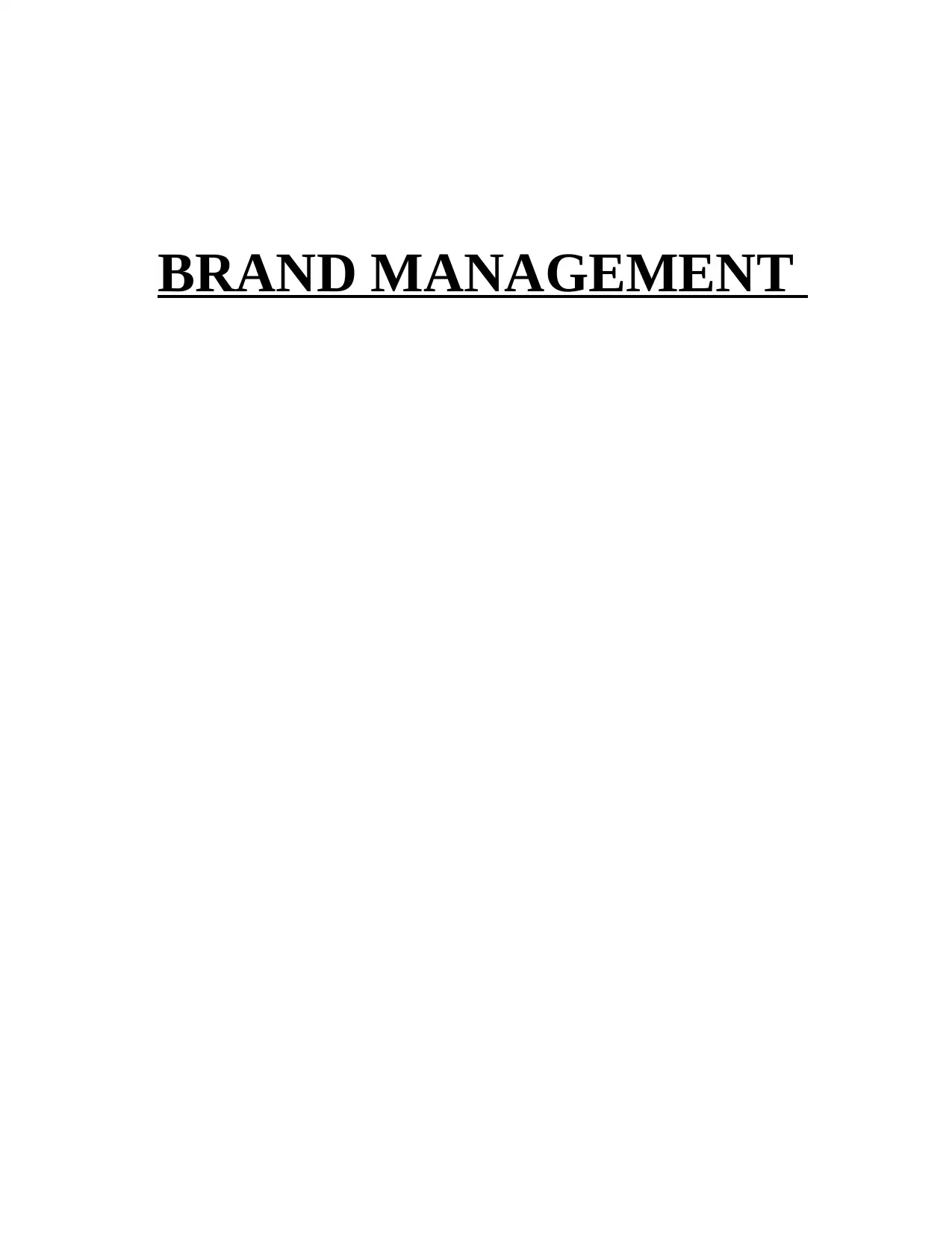
BRAND MANAGEMENT
Paraphrase This Document
Need a fresh take? Get an instant paraphrase of this document with our AI Paraphraser

TABLE OF CONTENTS
INTRODUCTION...........................................................................................................................1
TASK 1............................................................................................................................................1
TASK 2............................................................................................................................................4
Various strategies of portfolio management, brand hierarchy and brand equity........................4
Hierarchy management of brands...............................................................................................5
Critical analysis of portfolio management..................................................................................6
LO 3.................................................................................................................................................7
Ways in which brand is managed collaboratively and in partnership at global and domestic
level.............................................................................................................................................7
Critical evaluation of use of different techniques.......................................................................7
TASK 3............................................................................................................................................8
Different Techniques for Managing and Measuring the Brand Value of Dyson........................8
CONCLUSION..............................................................................................................................10
REFERENCES..............................................................................................................................11
INTRODUCTION...........................................................................................................................1
TASK 1............................................................................................................................................1
TASK 2............................................................................................................................................4
Various strategies of portfolio management, brand hierarchy and brand equity........................4
Hierarchy management of brands...............................................................................................5
Critical analysis of portfolio management..................................................................................6
LO 3.................................................................................................................................................7
Ways in which brand is managed collaboratively and in partnership at global and domestic
level.............................................................................................................................................7
Critical evaluation of use of different techniques.......................................................................7
TASK 3............................................................................................................................................8
Different Techniques for Managing and Measuring the Brand Value of Dyson........................8
CONCLUSION..............................................................................................................................10
REFERENCES..............................................................................................................................11
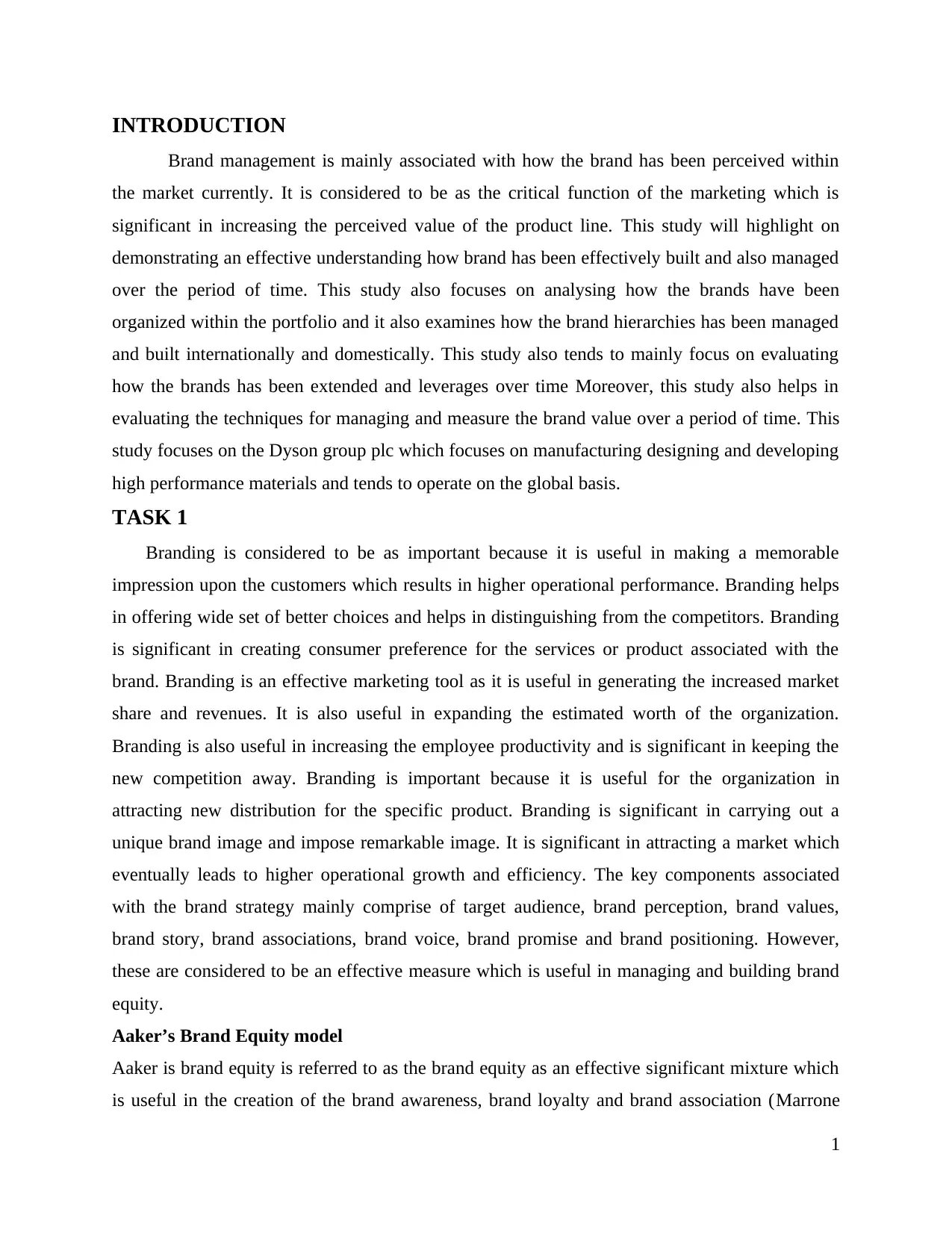
INTRODUCTION
Brand management is mainly associated with how the brand has been perceived within
the market currently. It is considered to be as the critical function of the marketing which is
significant in increasing the perceived value of the product line. This study will highlight on
demonstrating an effective understanding how brand has been effectively built and also managed
over the period of time. This study also focuses on analysing how the brands have been
organized within the portfolio and it also examines how the brand hierarchies has been managed
and built internationally and domestically. This study also tends to mainly focus on evaluating
how the brands has been extended and leverages over time Moreover, this study also helps in
evaluating the techniques for managing and measure the brand value over a period of time. This
study focuses on the Dyson group plc which focuses on manufacturing designing and developing
high performance materials and tends to operate on the global basis.
TASK 1
Branding is considered to be as important because it is useful in making a memorable
impression upon the customers which results in higher operational performance. Branding helps
in offering wide set of better choices and helps in distinguishing from the competitors. Branding
is significant in creating consumer preference for the services or product associated with the
brand. Branding is an effective marketing tool as it is useful in generating the increased market
share and revenues. It is also useful in expanding the estimated worth of the organization.
Branding is also useful in increasing the employee productivity and is significant in keeping the
new competition away. Branding is important because it is useful for the organization in
attracting new distribution for the specific product. Branding is significant in carrying out a
unique brand image and impose remarkable image. It is significant in attracting a market which
eventually leads to higher operational growth and efficiency. The key components associated
with the brand strategy mainly comprise of target audience, brand perception, brand values,
brand story, brand associations, brand voice, brand promise and brand positioning. However,
these are considered to be an effective measure which is useful in managing and building brand
equity.
Aaker’s Brand Equity model
Aaker is brand equity is referred to as the brand equity as an effective significant mixture which
is useful in the creation of the brand awareness, brand loyalty and brand association (Marrone
1
Brand management is mainly associated with how the brand has been perceived within
the market currently. It is considered to be as the critical function of the marketing which is
significant in increasing the perceived value of the product line. This study will highlight on
demonstrating an effective understanding how brand has been effectively built and also managed
over the period of time. This study also focuses on analysing how the brands have been
organized within the portfolio and it also examines how the brand hierarchies has been managed
and built internationally and domestically. This study also tends to mainly focus on evaluating
how the brands has been extended and leverages over time Moreover, this study also helps in
evaluating the techniques for managing and measure the brand value over a period of time. This
study focuses on the Dyson group plc which focuses on manufacturing designing and developing
high performance materials and tends to operate on the global basis.
TASK 1
Branding is considered to be as important because it is useful in making a memorable
impression upon the customers which results in higher operational performance. Branding helps
in offering wide set of better choices and helps in distinguishing from the competitors. Branding
is significant in creating consumer preference for the services or product associated with the
brand. Branding is an effective marketing tool as it is useful in generating the increased market
share and revenues. It is also useful in expanding the estimated worth of the organization.
Branding is also useful in increasing the employee productivity and is significant in keeping the
new competition away. Branding is important because it is useful for the organization in
attracting new distribution for the specific product. Branding is significant in carrying out a
unique brand image and impose remarkable image. It is significant in attracting a market which
eventually leads to higher operational growth and efficiency. The key components associated
with the brand strategy mainly comprise of target audience, brand perception, brand values,
brand story, brand associations, brand voice, brand promise and brand positioning. However,
these are considered to be an effective measure which is useful in managing and building brand
equity.
Aaker’s Brand Equity model
Aaker is brand equity is referred to as the brand equity as an effective significant mixture which
is useful in the creation of the brand awareness, brand loyalty and brand association (Marrone
1
⊘ This is a preview!⊘
Do you want full access?
Subscribe today to unlock all pages.

Trusted by 1+ million students worldwide
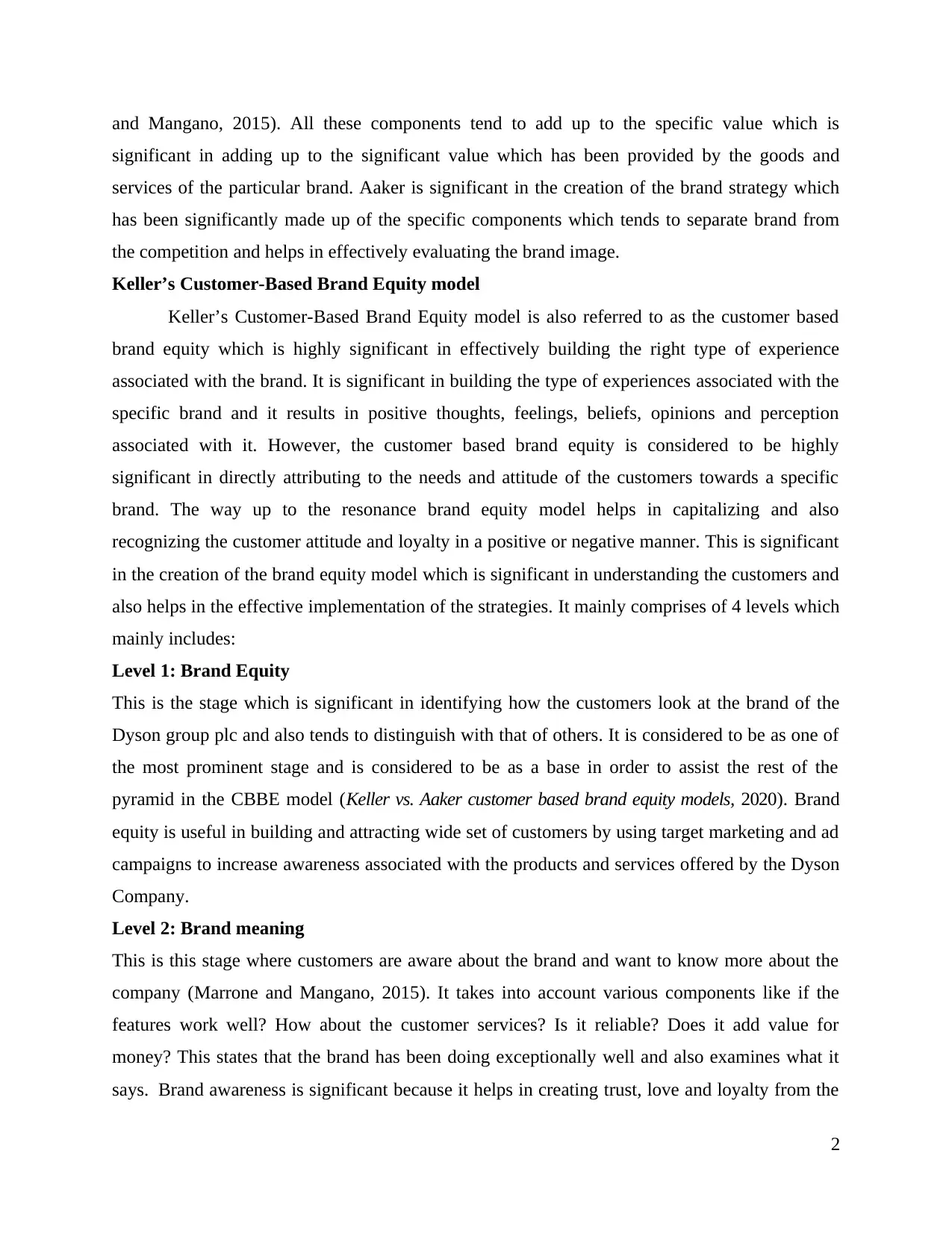
and Mangano, 2015). All these components tend to add up to the specific value which is
significant in adding up to the significant value which has been provided by the goods and
services of the particular brand. Aaker is significant in the creation of the brand strategy which
has been significantly made up of the specific components which tends to separate brand from
the competition and helps in effectively evaluating the brand image.
Keller’s Customer-Based Brand Equity model
Keller’s Customer-Based Brand Equity model is also referred to as the customer based
brand equity which is highly significant in effectively building the right type of experience
associated with the brand. It is significant in building the type of experiences associated with the
specific brand and it results in positive thoughts, feelings, beliefs, opinions and perception
associated with it. However, the customer based brand equity is considered to be highly
significant in directly attributing to the needs and attitude of the customers towards a specific
brand. The way up to the resonance brand equity model helps in capitalizing and also
recognizing the customer attitude and loyalty in a positive or negative manner. This is significant
in the creation of the brand equity model which is significant in understanding the customers and
also helps in the effective implementation of the strategies. It mainly comprises of 4 levels which
mainly includes:
Level 1: Brand Equity
This is the stage which is significant in identifying how the customers look at the brand of the
Dyson group plc and also tends to distinguish with that of others. It is considered to be as one of
the most prominent stage and is considered to be as a base in order to assist the rest of the
pyramid in the CBBE model (Keller vs. Aaker customer based brand equity models, 2020). Brand
equity is useful in building and attracting wide set of customers by using target marketing and ad
campaigns to increase awareness associated with the products and services offered by the Dyson
Company.
Level 2: Brand meaning
This is this stage where customers are aware about the brand and want to know more about the
company (Marrone and Mangano, 2015). It takes into account various components like if the
features work well? How about the customer services? Is it reliable? Does it add value for
money? This states that the brand has been doing exceptionally well and also examines what it
says. Brand awareness is significant because it helps in creating trust, love and loyalty from the
2
significant in adding up to the significant value which has been provided by the goods and
services of the particular brand. Aaker is significant in the creation of the brand strategy which
has been significantly made up of the specific components which tends to separate brand from
the competition and helps in effectively evaluating the brand image.
Keller’s Customer-Based Brand Equity model
Keller’s Customer-Based Brand Equity model is also referred to as the customer based
brand equity which is highly significant in effectively building the right type of experience
associated with the brand. It is significant in building the type of experiences associated with the
specific brand and it results in positive thoughts, feelings, beliefs, opinions and perception
associated with it. However, the customer based brand equity is considered to be highly
significant in directly attributing to the needs and attitude of the customers towards a specific
brand. The way up to the resonance brand equity model helps in capitalizing and also
recognizing the customer attitude and loyalty in a positive or negative manner. This is significant
in the creation of the brand equity model which is significant in understanding the customers and
also helps in the effective implementation of the strategies. It mainly comprises of 4 levels which
mainly includes:
Level 1: Brand Equity
This is the stage which is significant in identifying how the customers look at the brand of the
Dyson group plc and also tends to distinguish with that of others. It is considered to be as one of
the most prominent stage and is considered to be as a base in order to assist the rest of the
pyramid in the CBBE model (Keller vs. Aaker customer based brand equity models, 2020). Brand
equity is useful in building and attracting wide set of customers by using target marketing and ad
campaigns to increase awareness associated with the products and services offered by the Dyson
Company.
Level 2: Brand meaning
This is this stage where customers are aware about the brand and want to know more about the
company (Marrone and Mangano, 2015). It takes into account various components like if the
features work well? How about the customer services? Is it reliable? Does it add value for
money? This states that the brand has been doing exceptionally well and also examines what it
says. Brand awareness is significant because it helps in creating trust, love and loyalty from the
2
Paraphrase This Document
Need a fresh take? Get an instant paraphrase of this document with our AI Paraphraser
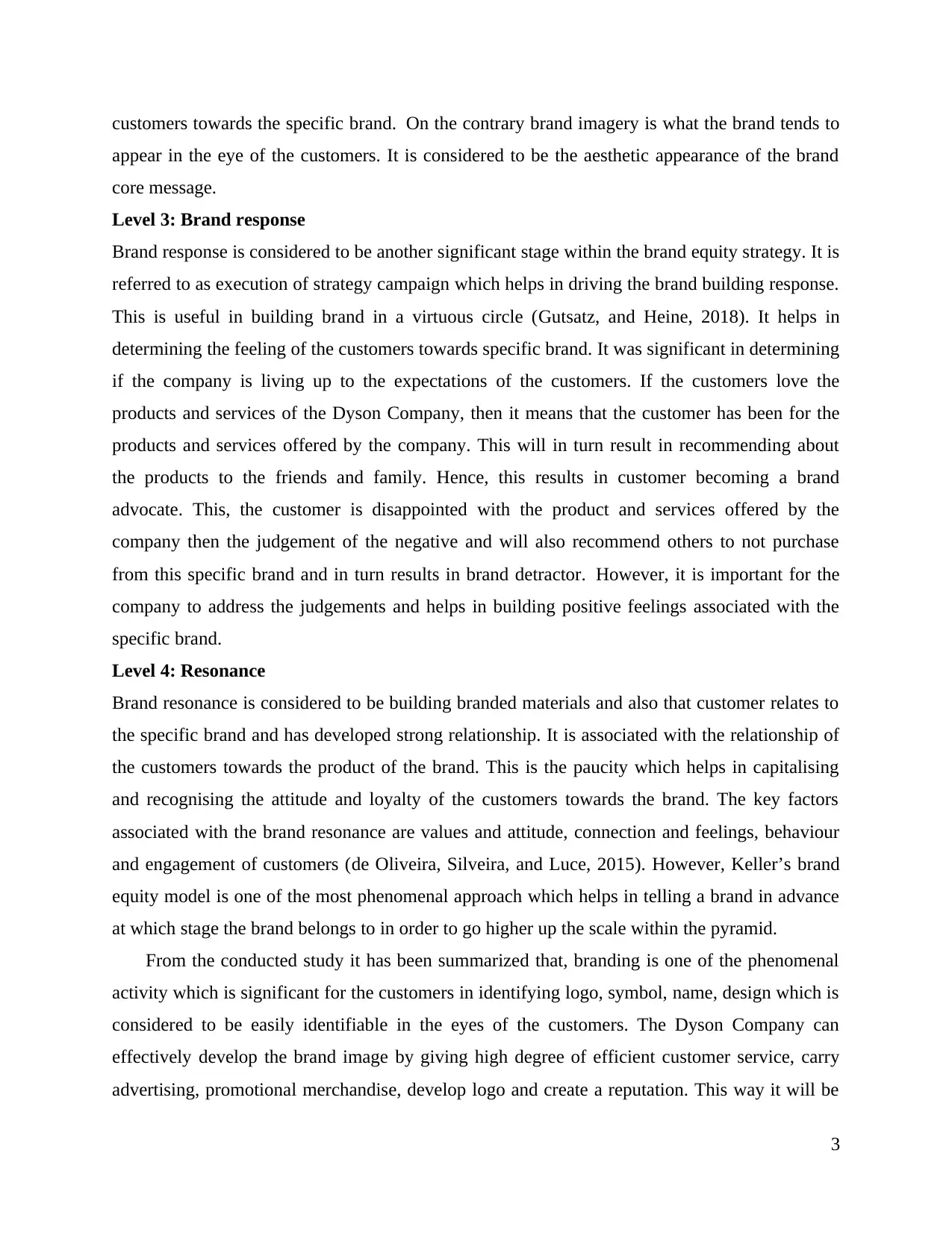
customers towards the specific brand. On the contrary brand imagery is what the brand tends to
appear in the eye of the customers. It is considered to be the aesthetic appearance of the brand
core message.
Level 3: Brand response
Brand response is considered to be another significant stage within the brand equity strategy. It is
referred to as execution of strategy campaign which helps in driving the brand building response.
This is useful in building brand in a virtuous circle (Gutsatz, and Heine, 2018). It helps in
determining the feeling of the customers towards specific brand. It was significant in determining
if the company is living up to the expectations of the customers. If the customers love the
products and services of the Dyson Company, then it means that the customer has been for the
products and services offered by the company. This will in turn result in recommending about
the products to the friends and family. Hence, this results in customer becoming a brand
advocate. This, the customer is disappointed with the product and services offered by the
company then the judgement of the negative and will also recommend others to not purchase
from this specific brand and in turn results in brand detractor. However, it is important for the
company to address the judgements and helps in building positive feelings associated with the
specific brand.
Level 4: Resonance
Brand resonance is considered to be building branded materials and also that customer relates to
the specific brand and has developed strong relationship. It is associated with the relationship of
the customers towards the product of the brand. This is the paucity which helps in capitalising
and recognising the attitude and loyalty of the customers towards the brand. The key factors
associated with the brand resonance are values and attitude, connection and feelings, behaviour
and engagement of customers (de Oliveira, Silveira, and Luce, 2015). However, Keller’s brand
equity model is one of the most phenomenal approach which helps in telling a brand in advance
at which stage the brand belongs to in order to go higher up the scale within the pyramid.
From the conducted study it has been summarized that, branding is one of the phenomenal
activity which is significant for the customers in identifying logo, symbol, name, design which is
considered to be easily identifiable in the eyes of the customers. The Dyson Company can
effectively develop the brand image by giving high degree of efficient customer service, carry
advertising, promotional merchandise, develop logo and create a reputation. This way it will be
3
appear in the eye of the customers. It is considered to be the aesthetic appearance of the brand
core message.
Level 3: Brand response
Brand response is considered to be another significant stage within the brand equity strategy. It is
referred to as execution of strategy campaign which helps in driving the brand building response.
This is useful in building brand in a virtuous circle (Gutsatz, and Heine, 2018). It helps in
determining the feeling of the customers towards specific brand. It was significant in determining
if the company is living up to the expectations of the customers. If the customers love the
products and services of the Dyson Company, then it means that the customer has been for the
products and services offered by the company. This will in turn result in recommending about
the products to the friends and family. Hence, this results in customer becoming a brand
advocate. This, the customer is disappointed with the product and services offered by the
company then the judgement of the negative and will also recommend others to not purchase
from this specific brand and in turn results in brand detractor. However, it is important for the
company to address the judgements and helps in building positive feelings associated with the
specific brand.
Level 4: Resonance
Brand resonance is considered to be building branded materials and also that customer relates to
the specific brand and has developed strong relationship. It is associated with the relationship of
the customers towards the product of the brand. This is the paucity which helps in capitalising
and recognising the attitude and loyalty of the customers towards the brand. The key factors
associated with the brand resonance are values and attitude, connection and feelings, behaviour
and engagement of customers (de Oliveira, Silveira, and Luce, 2015). However, Keller’s brand
equity model is one of the most phenomenal approach which helps in telling a brand in advance
at which stage the brand belongs to in order to go higher up the scale within the pyramid.
From the conducted study it has been summarized that, branding is one of the phenomenal
activity which is significant for the customers in identifying logo, symbol, name, design which is
considered to be easily identifiable in the eyes of the customers. The Dyson Company can
effectively develop the brand image by giving high degree of efficient customer service, carry
advertising, promotional merchandise, develop logo and create a reputation. This way it will be
3
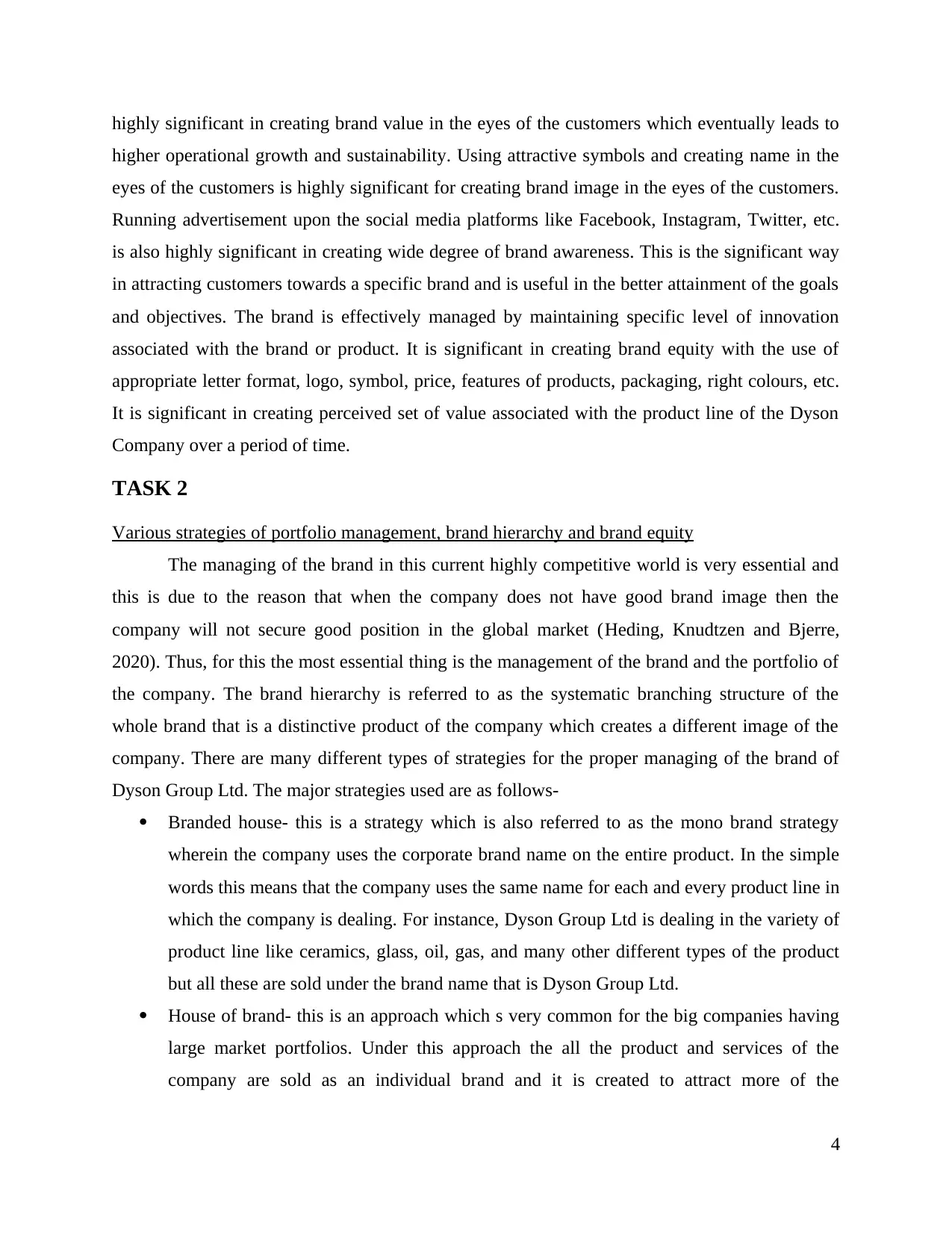
highly significant in creating brand value in the eyes of the customers which eventually leads to
higher operational growth and sustainability. Using attractive symbols and creating name in the
eyes of the customers is highly significant for creating brand image in the eyes of the customers.
Running advertisement upon the social media platforms like Facebook, Instagram, Twitter, etc.
is also highly significant in creating wide degree of brand awareness. This is the significant way
in attracting customers towards a specific brand and is useful in the better attainment of the goals
and objectives. The brand is effectively managed by maintaining specific level of innovation
associated with the brand or product. It is significant in creating brand equity with the use of
appropriate letter format, logo, symbol, price, features of products, packaging, right colours, etc.
It is significant in creating perceived set of value associated with the product line of the Dyson
Company over a period of time.
TASK 2
Various strategies of portfolio management, brand hierarchy and brand equity
The managing of the brand in this current highly competitive world is very essential and
this is due to the reason that when the company does not have good brand image then the
company will not secure good position in the global market (Heding, Knudtzen and Bjerre,
2020). Thus, for this the most essential thing is the management of the brand and the portfolio of
the company. The brand hierarchy is referred to as the systematic branching structure of the
whole brand that is a distinctive product of the company which creates a different image of the
company. There are many different types of strategies for the proper managing of the brand of
Dyson Group Ltd. The major strategies used are as follows-
Branded house- this is a strategy which is also referred to as the mono brand strategy
wherein the company uses the corporate brand name on the entire product. In the simple
words this means that the company uses the same name for each and every product line in
which the company is dealing. For instance, Dyson Group Ltd is dealing in the variety of
product line like ceramics, glass, oil, gas, and many other different types of the product
but all these are sold under the brand name that is Dyson Group Ltd.
House of brand- this is an approach which s very common for the big companies having
large market portfolios. Under this approach the all the product and services of the
company are sold as an individual brand and it is created to attract more of the
4
higher operational growth and sustainability. Using attractive symbols and creating name in the
eyes of the customers is highly significant for creating brand image in the eyes of the customers.
Running advertisement upon the social media platforms like Facebook, Instagram, Twitter, etc.
is also highly significant in creating wide degree of brand awareness. This is the significant way
in attracting customers towards a specific brand and is useful in the better attainment of the goals
and objectives. The brand is effectively managed by maintaining specific level of innovation
associated with the brand or product. It is significant in creating brand equity with the use of
appropriate letter format, logo, symbol, price, features of products, packaging, right colours, etc.
It is significant in creating perceived set of value associated with the product line of the Dyson
Company over a period of time.
TASK 2
Various strategies of portfolio management, brand hierarchy and brand equity
The managing of the brand in this current highly competitive world is very essential and
this is due to the reason that when the company does not have good brand image then the
company will not secure good position in the global market (Heding, Knudtzen and Bjerre,
2020). Thus, for this the most essential thing is the management of the brand and the portfolio of
the company. The brand hierarchy is referred to as the systematic branching structure of the
whole brand that is a distinctive product of the company which creates a different image of the
company. There are many different types of strategies for the proper managing of the brand of
Dyson Group Ltd. The major strategies used are as follows-
Branded house- this is a strategy which is also referred to as the mono brand strategy
wherein the company uses the corporate brand name on the entire product. In the simple
words this means that the company uses the same name for each and every product line in
which the company is dealing. For instance, Dyson Group Ltd is dealing in the variety of
product line like ceramics, glass, oil, gas, and many other different types of the product
but all these are sold under the brand name that is Dyson Group Ltd.
House of brand- this is an approach which s very common for the big companies having
large market portfolios. Under this approach the all the product and services of the
company are sold as an individual brand and it is created to attract more of the
4
⊘ This is a preview!⊘
Do you want full access?
Subscribe today to unlock all pages.

Trusted by 1+ million students worldwide
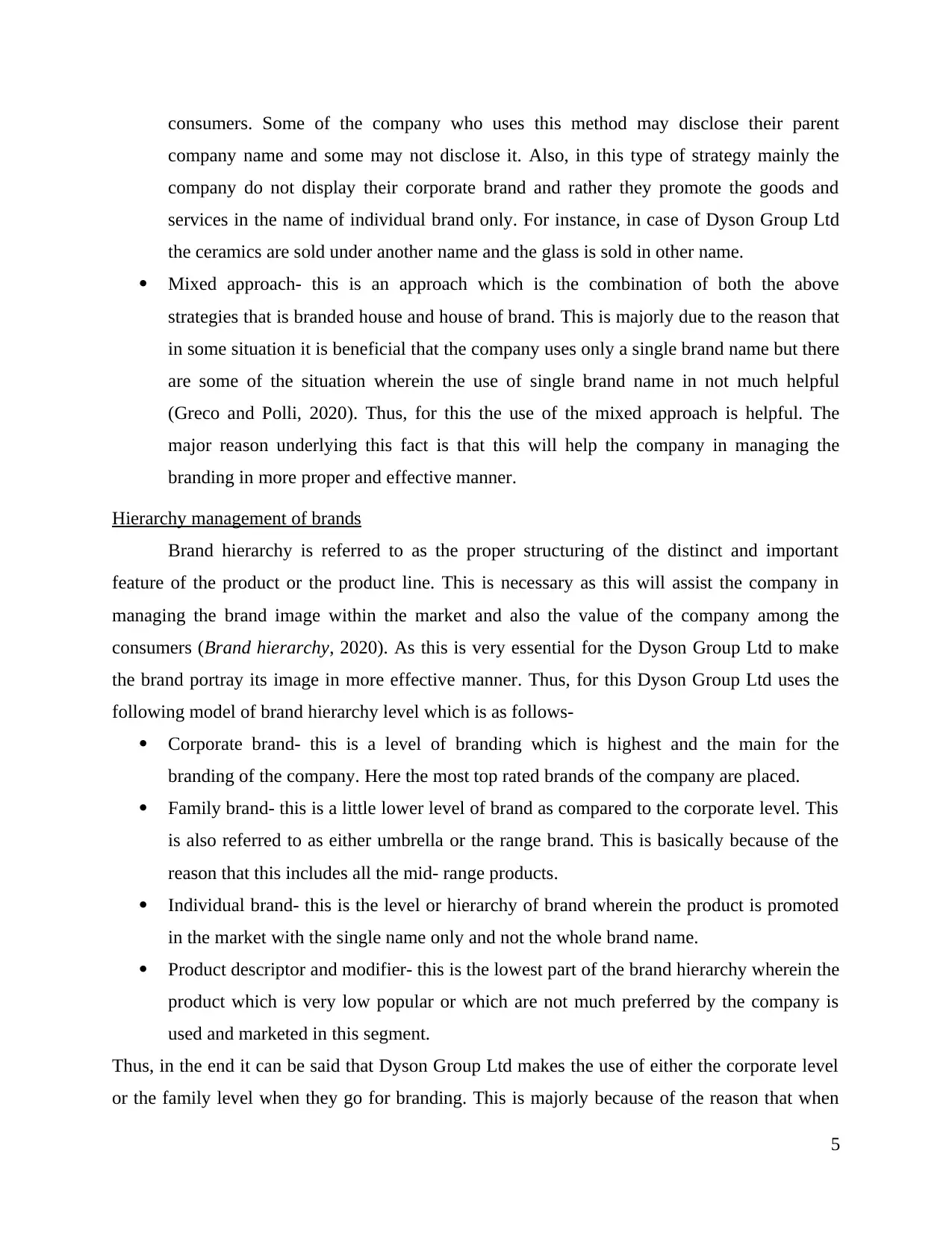
consumers. Some of the company who uses this method may disclose their parent
company name and some may not disclose it. Also, in this type of strategy mainly the
company do not display their corporate brand and rather they promote the goods and
services in the name of individual brand only. For instance, in case of Dyson Group Ltd
the ceramics are sold under another name and the glass is sold in other name.
Mixed approach- this is an approach which is the combination of both the above
strategies that is branded house and house of brand. This is majorly due to the reason that
in some situation it is beneficial that the company uses only a single brand name but there
are some of the situation wherein the use of single brand name in not much helpful
(Greco and Polli, 2020). Thus, for this the use of the mixed approach is helpful. The
major reason underlying this fact is that this will help the company in managing the
branding in more proper and effective manner.
Hierarchy management of brands
Brand hierarchy is referred to as the proper structuring of the distinct and important
feature of the product or the product line. This is necessary as this will assist the company in
managing the brand image within the market and also the value of the company among the
consumers (Brand hierarchy, 2020). As this is very essential for the Dyson Group Ltd to make
the brand portray its image in more effective manner. Thus, for this Dyson Group Ltd uses the
following model of brand hierarchy level which is as follows-
Corporate brand- this is a level of branding which is highest and the main for the
branding of the company. Here the most top rated brands of the company are placed.
Family brand- this is a little lower level of brand as compared to the corporate level. This
is also referred to as either umbrella or the range brand. This is basically because of the
reason that this includes all the mid- range products.
Individual brand- this is the level or hierarchy of brand wherein the product is promoted
in the market with the single name only and not the whole brand name.
Product descriptor and modifier- this is the lowest part of the brand hierarchy wherein the
product which is very low popular or which are not much preferred by the company is
used and marketed in this segment.
Thus, in the end it can be said that Dyson Group Ltd makes the use of either the corporate level
or the family level when they go for branding. This is majorly because of the reason that when
5
company name and some may not disclose it. Also, in this type of strategy mainly the
company do not display their corporate brand and rather they promote the goods and
services in the name of individual brand only. For instance, in case of Dyson Group Ltd
the ceramics are sold under another name and the glass is sold in other name.
Mixed approach- this is an approach which is the combination of both the above
strategies that is branded house and house of brand. This is majorly due to the reason that
in some situation it is beneficial that the company uses only a single brand name but there
are some of the situation wherein the use of single brand name in not much helpful
(Greco and Polli, 2020). Thus, for this the use of the mixed approach is helpful. The
major reason underlying this fact is that this will help the company in managing the
branding in more proper and effective manner.
Hierarchy management of brands
Brand hierarchy is referred to as the proper structuring of the distinct and important
feature of the product or the product line. This is necessary as this will assist the company in
managing the brand image within the market and also the value of the company among the
consumers (Brand hierarchy, 2020). As this is very essential for the Dyson Group Ltd to make
the brand portray its image in more effective manner. Thus, for this Dyson Group Ltd uses the
following model of brand hierarchy level which is as follows-
Corporate brand- this is a level of branding which is highest and the main for the
branding of the company. Here the most top rated brands of the company are placed.
Family brand- this is a little lower level of brand as compared to the corporate level. This
is also referred to as either umbrella or the range brand. This is basically because of the
reason that this includes all the mid- range products.
Individual brand- this is the level or hierarchy of brand wherein the product is promoted
in the market with the single name only and not the whole brand name.
Product descriptor and modifier- this is the lowest part of the brand hierarchy wherein the
product which is very low popular or which are not much preferred by the company is
used and marketed in this segment.
Thus, in the end it can be said that Dyson Group Ltd makes the use of either the corporate level
or the family level when they go for branding. This is majorly because of the reason that when
5
Paraphrase This Document
Need a fresh take? Get an instant paraphrase of this document with our AI Paraphraser
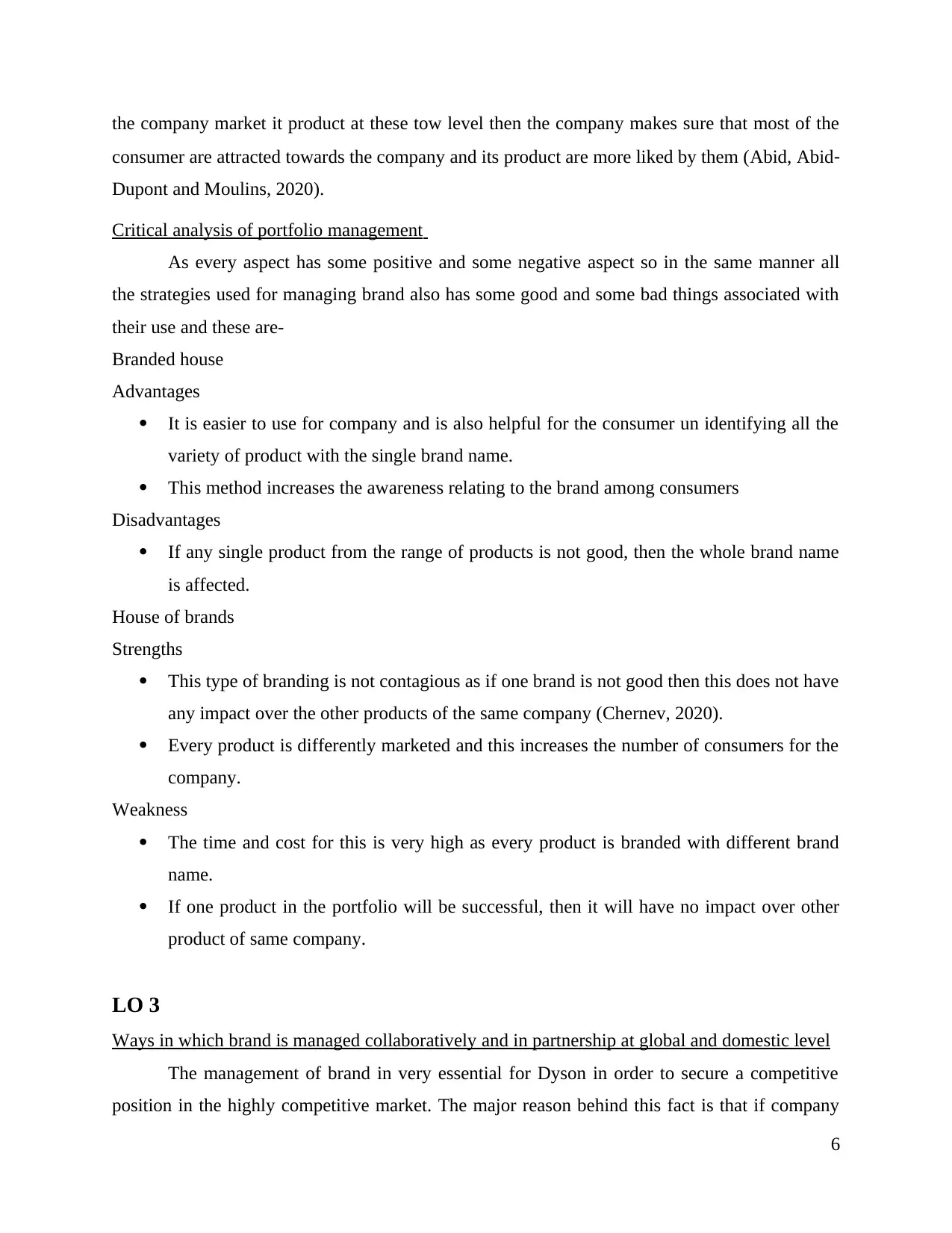
the company market it product at these tow level then the company makes sure that most of the
consumer are attracted towards the company and its product are more liked by them (Abid, Abid‐
Dupont and Moulins, 2020).
Critical analysis of portfolio management
As every aspect has some positive and some negative aspect so in the same manner all
the strategies used for managing brand also has some good and some bad things associated with
their use and these are-
Branded house
Advantages
It is easier to use for company and is also helpful for the consumer un identifying all the
variety of product with the single brand name.
This method increases the awareness relating to the brand among consumers
Disadvantages
If any single product from the range of products is not good, then the whole brand name
is affected.
House of brands
Strengths
This type of branding is not contagious as if one brand is not good then this does not have
any impact over the other products of the same company (Chernev, 2020).
Every product is differently marketed and this increases the number of consumers for the
company.
Weakness
The time and cost for this is very high as every product is branded with different brand
name.
If one product in the portfolio will be successful, then it will have no impact over other
product of same company.
LO 3
Ways in which brand is managed collaboratively and in partnership at global and domestic level
The management of brand in very essential for Dyson in order to secure a competitive
position in the highly competitive market. The major reason behind this fact is that if company
6
consumer are attracted towards the company and its product are more liked by them (Abid, Abid‐
Dupont and Moulins, 2020).
Critical analysis of portfolio management
As every aspect has some positive and some negative aspect so in the same manner all
the strategies used for managing brand also has some good and some bad things associated with
their use and these are-
Branded house
Advantages
It is easier to use for company and is also helpful for the consumer un identifying all the
variety of product with the single brand name.
This method increases the awareness relating to the brand among consumers
Disadvantages
If any single product from the range of products is not good, then the whole brand name
is affected.
House of brands
Strengths
This type of branding is not contagious as if one brand is not good then this does not have
any impact over the other products of the same company (Chernev, 2020).
Every product is differently marketed and this increases the number of consumers for the
company.
Weakness
The time and cost for this is very high as every product is branded with different brand
name.
If one product in the portfolio will be successful, then it will have no impact over other
product of same company.
LO 3
Ways in which brand is managed collaboratively and in partnership at global and domestic level
The management of brand in very essential for Dyson in order to secure a competitive
position in the highly competitive market. The major reason behind this fact is that if company
6
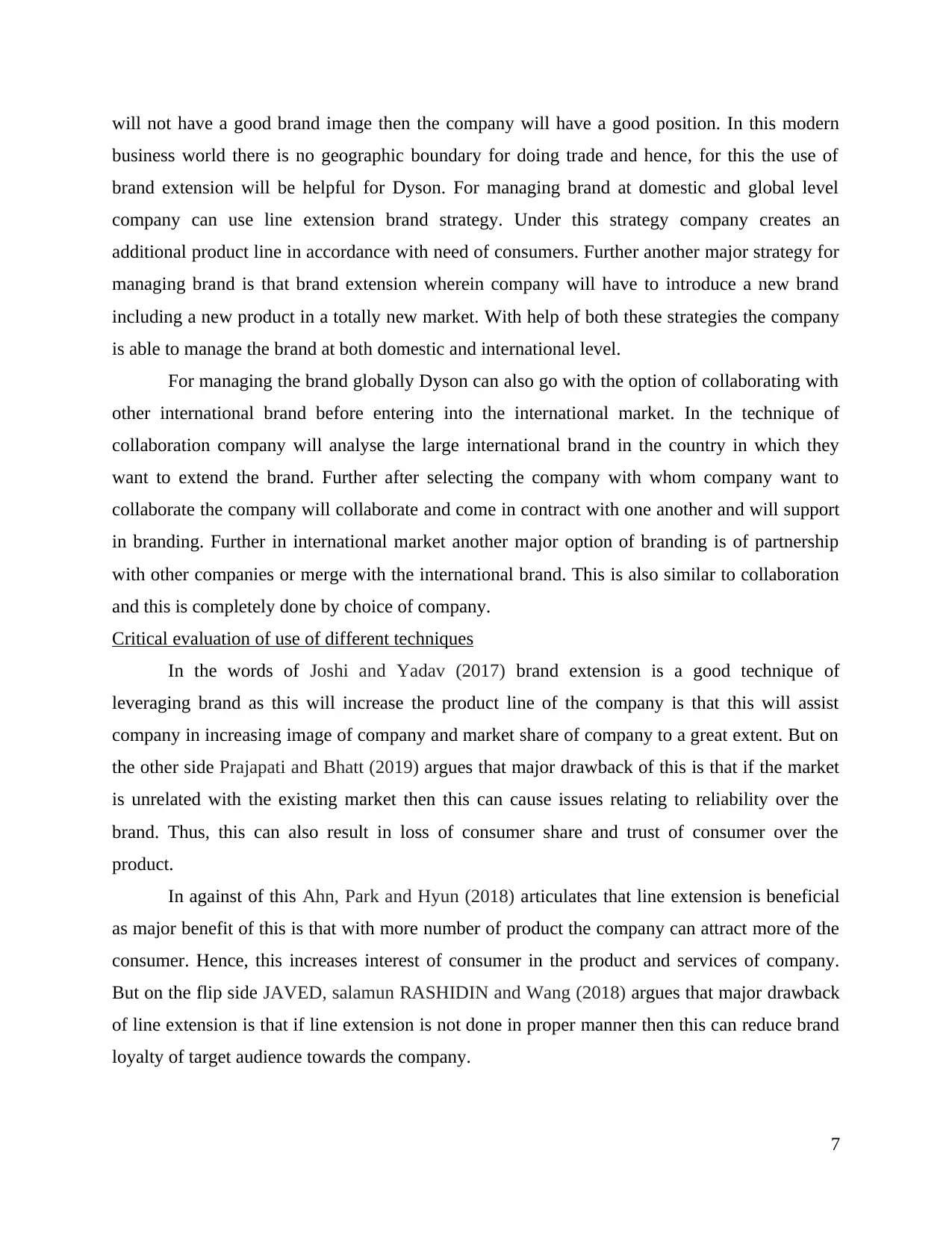
will not have a good brand image then the company will have a good position. In this modern
business world there is no geographic boundary for doing trade and hence, for this the use of
brand extension will be helpful for Dyson. For managing brand at domestic and global level
company can use line extension brand strategy. Under this strategy company creates an
additional product line in accordance with need of consumers. Further another major strategy for
managing brand is that brand extension wherein company will have to introduce a new brand
including a new product in a totally new market. With help of both these strategies the company
is able to manage the brand at both domestic and international level.
For managing the brand globally Dyson can also go with the option of collaborating with
other international brand before entering into the international market. In the technique of
collaboration company will analyse the large international brand in the country in which they
want to extend the brand. Further after selecting the company with whom company want to
collaborate the company will collaborate and come in contract with one another and will support
in branding. Further in international market another major option of branding is of partnership
with other companies or merge with the international brand. This is also similar to collaboration
and this is completely done by choice of company.
Critical evaluation of use of different techniques
In the words of Joshi and Yadav (2017) brand extension is a good technique of
leveraging brand as this will increase the product line of the company is that this will assist
company in increasing image of company and market share of company to a great extent. But on
the other side Prajapati and Bhatt (2019) argues that major drawback of this is that if the market
is unrelated with the existing market then this can cause issues relating to reliability over the
brand. Thus, this can also result in loss of consumer share and trust of consumer over the
product.
In against of this Ahn, Park and Hyun (2018) articulates that line extension is beneficial
as major benefit of this is that with more number of product the company can attract more of the
consumer. Hence, this increases interest of consumer in the product and services of company.
But on the flip side JAVED, salamun RASHIDIN and Wang (2018) argues that major drawback
of line extension is that if line extension is not done in proper manner then this can reduce brand
loyalty of target audience towards the company.
7
business world there is no geographic boundary for doing trade and hence, for this the use of
brand extension will be helpful for Dyson. For managing brand at domestic and global level
company can use line extension brand strategy. Under this strategy company creates an
additional product line in accordance with need of consumers. Further another major strategy for
managing brand is that brand extension wherein company will have to introduce a new brand
including a new product in a totally new market. With help of both these strategies the company
is able to manage the brand at both domestic and international level.
For managing the brand globally Dyson can also go with the option of collaborating with
other international brand before entering into the international market. In the technique of
collaboration company will analyse the large international brand in the country in which they
want to extend the brand. Further after selecting the company with whom company want to
collaborate the company will collaborate and come in contract with one another and will support
in branding. Further in international market another major option of branding is of partnership
with other companies or merge with the international brand. This is also similar to collaboration
and this is completely done by choice of company.
Critical evaluation of use of different techniques
In the words of Joshi and Yadav (2017) brand extension is a good technique of
leveraging brand as this will increase the product line of the company is that this will assist
company in increasing image of company and market share of company to a great extent. But on
the other side Prajapati and Bhatt (2019) argues that major drawback of this is that if the market
is unrelated with the existing market then this can cause issues relating to reliability over the
brand. Thus, this can also result in loss of consumer share and trust of consumer over the
product.
In against of this Ahn, Park and Hyun (2018) articulates that line extension is beneficial
as major benefit of this is that with more number of product the company can attract more of the
consumer. Hence, this increases interest of consumer in the product and services of company.
But on the flip side JAVED, salamun RASHIDIN and Wang (2018) argues that major drawback
of line extension is that if line extension is not done in proper manner then this can reduce brand
loyalty of target audience towards the company.
7
⊘ This is a preview!⊘
Do you want full access?
Subscribe today to unlock all pages.

Trusted by 1+ million students worldwide
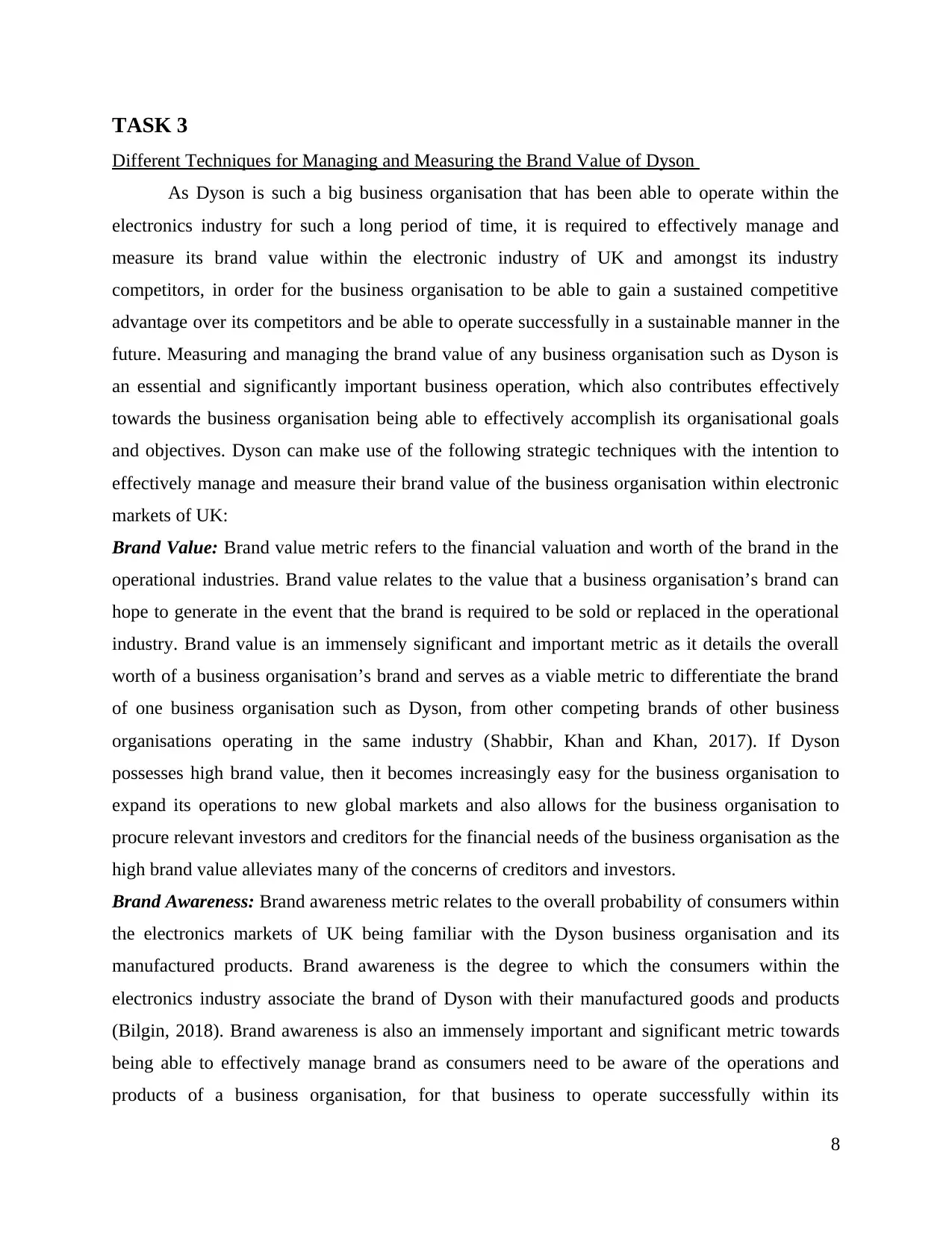
TASK 3
Different Techniques for Managing and Measuring the Brand Value of Dyson
As Dyson is such a big business organisation that has been able to operate within the
electronics industry for such a long period of time, it is required to effectively manage and
measure its brand value within the electronic industry of UK and amongst its industry
competitors, in order for the business organisation to be able to gain a sustained competitive
advantage over its competitors and be able to operate successfully in a sustainable manner in the
future. Measuring and managing the brand value of any business organisation such as Dyson is
an essential and significantly important business operation, which also contributes effectively
towards the business organisation being able to effectively accomplish its organisational goals
and objectives. Dyson can make use of the following strategic techniques with the intention to
effectively manage and measure their brand value of the business organisation within electronic
markets of UK:
Brand Value: Brand value metric refers to the financial valuation and worth of the brand in the
operational industries. Brand value relates to the value that a business organisation’s brand can
hope to generate in the event that the brand is required to be sold or replaced in the operational
industry. Brand value is an immensely significant and important metric as it details the overall
worth of a business organisation’s brand and serves as a viable metric to differentiate the brand
of one business organisation such as Dyson, from other competing brands of other business
organisations operating in the same industry (Shabbir, Khan and Khan, 2017). If Dyson
possesses high brand value, then it becomes increasingly easy for the business organisation to
expand its operations to new global markets and also allows for the business organisation to
procure relevant investors and creditors for the financial needs of the business organisation as the
high brand value alleviates many of the concerns of creditors and investors.
Brand Awareness: Brand awareness metric relates to the overall probability of consumers within
the electronics markets of UK being familiar with the Dyson business organisation and its
manufactured products. Brand awareness is the degree to which the consumers within the
electronics industry associate the brand of Dyson with their manufactured goods and products
(Bilgin, 2018). Brand awareness is also an immensely important and significant metric towards
being able to effectively manage brand as consumers need to be aware of the operations and
products of a business organisation, for that business to operate successfully within its
8
Different Techniques for Managing and Measuring the Brand Value of Dyson
As Dyson is such a big business organisation that has been able to operate within the
electronics industry for such a long period of time, it is required to effectively manage and
measure its brand value within the electronic industry of UK and amongst its industry
competitors, in order for the business organisation to be able to gain a sustained competitive
advantage over its competitors and be able to operate successfully in a sustainable manner in the
future. Measuring and managing the brand value of any business organisation such as Dyson is
an essential and significantly important business operation, which also contributes effectively
towards the business organisation being able to effectively accomplish its organisational goals
and objectives. Dyson can make use of the following strategic techniques with the intention to
effectively manage and measure their brand value of the business organisation within electronic
markets of UK:
Brand Value: Brand value metric refers to the financial valuation and worth of the brand in the
operational industries. Brand value relates to the value that a business organisation’s brand can
hope to generate in the event that the brand is required to be sold or replaced in the operational
industry. Brand value is an immensely significant and important metric as it details the overall
worth of a business organisation’s brand and serves as a viable metric to differentiate the brand
of one business organisation such as Dyson, from other competing brands of other business
organisations operating in the same industry (Shabbir, Khan and Khan, 2017). If Dyson
possesses high brand value, then it becomes increasingly easy for the business organisation to
expand its operations to new global markets and also allows for the business organisation to
procure relevant investors and creditors for the financial needs of the business organisation as the
high brand value alleviates many of the concerns of creditors and investors.
Brand Awareness: Brand awareness metric relates to the overall probability of consumers within
the electronics markets of UK being familiar with the Dyson business organisation and its
manufactured products. Brand awareness is the degree to which the consumers within the
electronics industry associate the brand of Dyson with their manufactured goods and products
(Bilgin, 2018). Brand awareness is also an immensely important and significant metric towards
being able to effectively manage brand as consumers need to be aware of the operations and
products of a business organisation, for that business to operate successfully within its
8
Paraphrase This Document
Need a fresh take? Get an instant paraphrase of this document with our AI Paraphraser
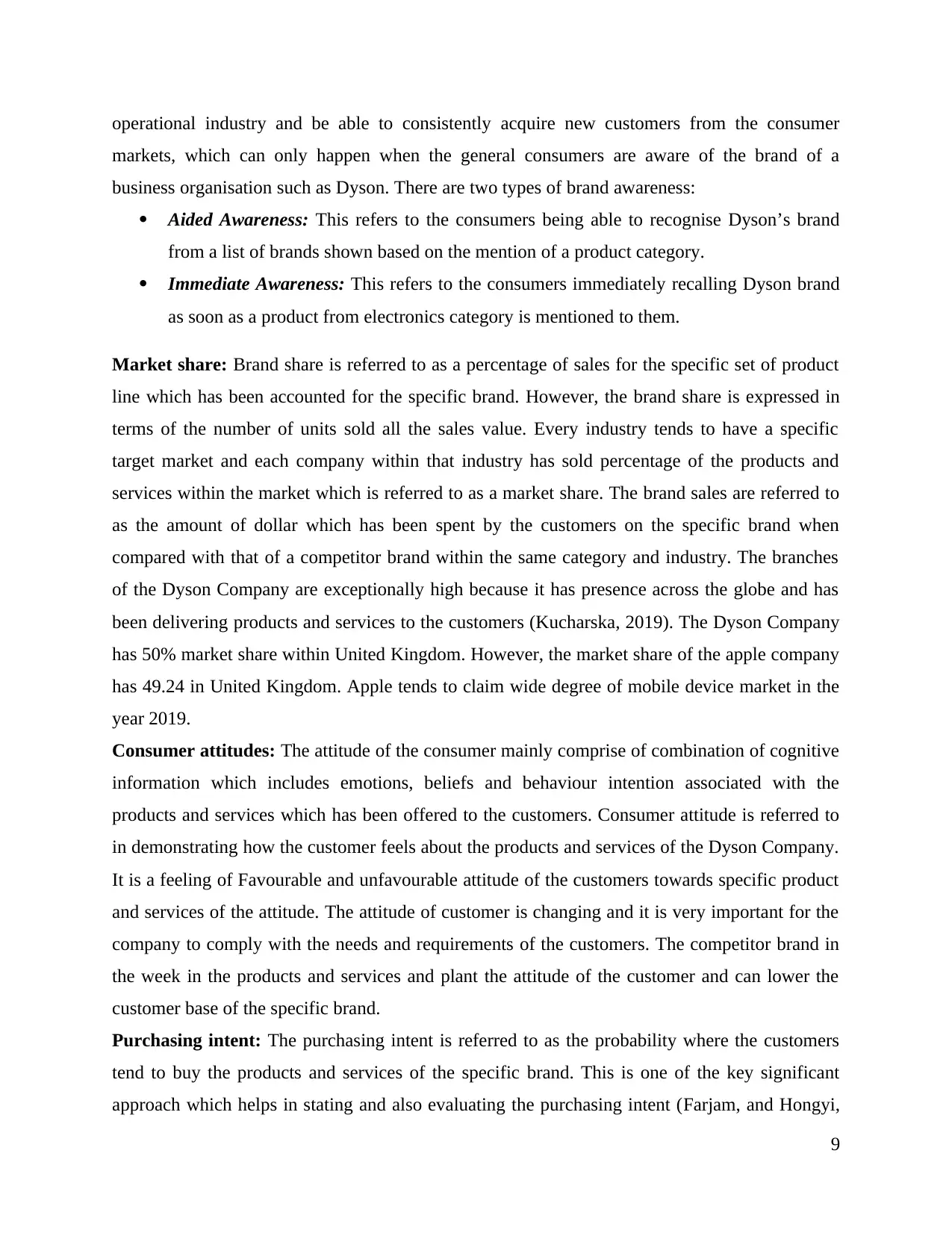
operational industry and be able to consistently acquire new customers from the consumer
markets, which can only happen when the general consumers are aware of the brand of a
business organisation such as Dyson. There are two types of brand awareness:
Aided Awareness: This refers to the consumers being able to recognise Dyson’s brand
from a list of brands shown based on the mention of a product category.
Immediate Awareness: This refers to the consumers immediately recalling Dyson brand
as soon as a product from electronics category is mentioned to them.
Market share: Brand share is referred to as a percentage of sales for the specific set of product
line which has been accounted for the specific brand. However, the brand share is expressed in
terms of the number of units sold all the sales value. Every industry tends to have a specific
target market and each company within that industry has sold percentage of the products and
services within the market which is referred to as a market share. The brand sales are referred to
as the amount of dollar which has been spent by the customers on the specific brand when
compared with that of a competitor brand within the same category and industry. The branches
of the Dyson Company are exceptionally high because it has presence across the globe and has
been delivering products and services to the customers (Kucharska, 2019). The Dyson Company
has 50% market share within United Kingdom. However, the market share of the apple company
has 49.24 in United Kingdom. Apple tends to claim wide degree of mobile device market in the
year 2019.
Consumer attitudes: The attitude of the consumer mainly comprise of combination of cognitive
information which includes emotions, beliefs and behaviour intention associated with the
products and services which has been offered to the customers. Consumer attitude is referred to
in demonstrating how the customer feels about the products and services of the Dyson Company.
It is a feeling of Favourable and unfavourable attitude of the customers towards specific product
and services of the attitude. The attitude of customer is changing and it is very important for the
company to comply with the needs and requirements of the customers. The competitor brand in
the week in the products and services and plant the attitude of the customer and can lower the
customer base of the specific brand.
Purchasing intent: The purchasing intent is referred to as the probability where the customers
tend to buy the products and services of the specific brand. This is one of the key significant
approach which helps in stating and also evaluating the purchasing intent (Farjam, and Hongyi,
9
markets, which can only happen when the general consumers are aware of the brand of a
business organisation such as Dyson. There are two types of brand awareness:
Aided Awareness: This refers to the consumers being able to recognise Dyson’s brand
from a list of brands shown based on the mention of a product category.
Immediate Awareness: This refers to the consumers immediately recalling Dyson brand
as soon as a product from electronics category is mentioned to them.
Market share: Brand share is referred to as a percentage of sales for the specific set of product
line which has been accounted for the specific brand. However, the brand share is expressed in
terms of the number of units sold all the sales value. Every industry tends to have a specific
target market and each company within that industry has sold percentage of the products and
services within the market which is referred to as a market share. The brand sales are referred to
as the amount of dollar which has been spent by the customers on the specific brand when
compared with that of a competitor brand within the same category and industry. The branches
of the Dyson Company are exceptionally high because it has presence across the globe and has
been delivering products and services to the customers (Kucharska, 2019). The Dyson Company
has 50% market share within United Kingdom. However, the market share of the apple company
has 49.24 in United Kingdom. Apple tends to claim wide degree of mobile device market in the
year 2019.
Consumer attitudes: The attitude of the consumer mainly comprise of combination of cognitive
information which includes emotions, beliefs and behaviour intention associated with the
products and services which has been offered to the customers. Consumer attitude is referred to
in demonstrating how the customer feels about the products and services of the Dyson Company.
It is a feeling of Favourable and unfavourable attitude of the customers towards specific product
and services of the attitude. The attitude of customer is changing and it is very important for the
company to comply with the needs and requirements of the customers. The competitor brand in
the week in the products and services and plant the attitude of the customer and can lower the
customer base of the specific brand.
Purchasing intent: The purchasing intent is referred to as the probability where the customers
tend to buy the products and services of the specific brand. This is one of the key significant
approach which helps in stating and also evaluating the purchasing intent (Farjam, and Hongyi,
9

2015). This is a significant measure where the marketers of the company tend to use predictive
set of modelling which helps in identifying the key possibility of the future outcomes as on the
basis of the historical data. This is one of the key significant techniques where the customer of
the Dyson Company tends to relevantly express the actual desire of the customer to buy the
specific products and services. This is significant in evaluating the behaviour of the customers
rather than demonstrating the vague interest.
CONCLUSION
From the conducted study it has been summarized that, Branding is an effective
marketing tool as it is useful in generating the increased market share and revenues. Aaker is
brand equity model significantly made up of the specific components which tends to separate
brand from the competition. Keller’s Customer-Based Brand Equity model is significant in
building the type of experiences associated with the specific brand and mainly comprise of four
levels i.e., brand equity, brand meaning, brand response and resonance. Also, from the above
whole study it was outlined that the use of the branding and the managing of the portfolio of
different brand is very essential for the company. This is necessary as if the company will
promote the goods and services in better terms then the profitability of company will increase.
Thus, for the management of brand the various strategies are house of brand, banded
house and many others. Measuring and managing the brand value of any business organisation is
an essential and significantly important business operation, which also contributes effectively
towards the business. Brand awareness metric relates to the overall probability of consumers.
The brand sales are referred to as the amount of dollar which has been spent by the customers on
the specific brand. The attitude of customer is changing and it is very important for the company
to comply with the needs and requirements of the customers in order to sustain in the market for
long run.
10
set of modelling which helps in identifying the key possibility of the future outcomes as on the
basis of the historical data. This is one of the key significant techniques where the customer of
the Dyson Company tends to relevantly express the actual desire of the customer to buy the
specific products and services. This is significant in evaluating the behaviour of the customers
rather than demonstrating the vague interest.
CONCLUSION
From the conducted study it has been summarized that, Branding is an effective
marketing tool as it is useful in generating the increased market share and revenues. Aaker is
brand equity model significantly made up of the specific components which tends to separate
brand from the competition. Keller’s Customer-Based Brand Equity model is significant in
building the type of experiences associated with the specific brand and mainly comprise of four
levels i.e., brand equity, brand meaning, brand response and resonance. Also, from the above
whole study it was outlined that the use of the branding and the managing of the portfolio of
different brand is very essential for the company. This is necessary as if the company will
promote the goods and services in better terms then the profitability of company will increase.
Thus, for the management of brand the various strategies are house of brand, banded
house and many others. Measuring and managing the brand value of any business organisation is
an essential and significantly important business operation, which also contributes effectively
towards the business. Brand awareness metric relates to the overall probability of consumers.
The brand sales are referred to as the amount of dollar which has been spent by the customers on
the specific brand. The attitude of customer is changing and it is very important for the company
to comply with the needs and requirements of the customers in order to sustain in the market for
long run.
10
⊘ This is a preview!⊘
Do you want full access?
Subscribe today to unlock all pages.

Trusted by 1+ million students worldwide
1 out of 14
Related Documents
Your All-in-One AI-Powered Toolkit for Academic Success.
+13062052269
info@desklib.com
Available 24*7 on WhatsApp / Email
![[object Object]](/_next/static/media/star-bottom.7253800d.svg)
Unlock your academic potential
Copyright © 2020–2025 A2Z Services. All Rights Reserved. Developed and managed by ZUCOL.





